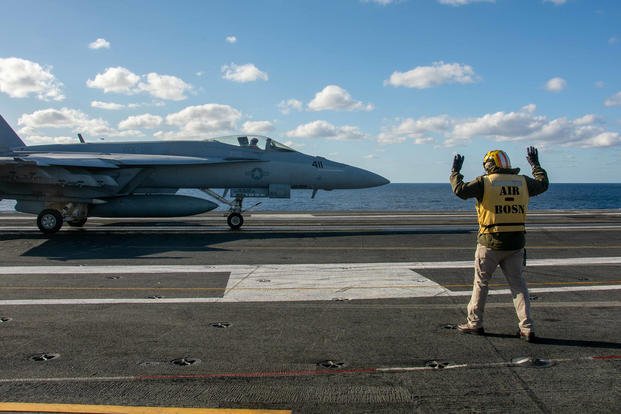The USS Ronald Reagan nuclear-powered aircraft carrier is returning to waters off the coast of South Korea in the latest show of strength after North Korea's most provocative missile test in years.
A Navy spokesperson confirmed Wednesday the Ronald Reagan Carrier Strike Group is now in the Sea of Japan, which is off the Korean peninsula's east coast, but declined to comment further on "future operations."
The decision to send the carrier back toward the Korean peninsula comes after Pyongyang on Tuesday test-fired an intermediate-range missile that flew directly over Japan before falling into the Pacific Ocean.
Read Next: The Army Cut Women's Clothing Allowance While Awarding Men More Money
The test was the first North Korean missile to fly over Japan since 2017 and the fifth launch in the last 10 days.
Tuesday's missile launch caused Japanese officials to warn citizens to take cover and prompted a harsh rebuke from U.S. officials, with National Security Council spokesperson Adrienne Watson calling it a "dangerous and reckless decision."
The Navy's confirmation of the Reagan's location comes after the South Korean military announced the carrier's redeployment to the area earlier Wednesday.
The statement from South Korea's Joint Chiefs of Staff said the move showed the "firm will" of the U.S. and South Korean alliance, according to The Associated Press.
The Japan-based Reagan had just concluded a joint exercise with the South Korean and Japanese navies in the area on Friday. Before the drills, the ship docked in the southern city of Busan, the first port call by a U.S. carrier in South Korea in four years. Earlier this week, the ship was operating east of Japan, according to the U.S. Naval Institute's fleet tracker.
North Korean missile activity picked up after U.S. and South Korean forces in August held their biggest joint military exercises in five years and after Vice President Kamala Harris visited the peninsula, including a stop in the demilitarized zone separating the two Koreas, last week.
In addition to moving the aircraft carrier, the U.S. military responded to the latest North Korean missile launch in separate joint drills with the South Korean and Japanese military, according to statements from U.S. Indo-Pacific Command, or Indo-Pacom.
The joint U.S.-South Korean drills included bombing a range on an uninhabited island in the Yellow Sea, with the participation of four South Korean F-15K fighter jets and four U.S. Air Force F-16 Fighting Falcon fighters. But in an embarrassment, a South Korean missile malfunctioned and blew up, falling off an aircraft shortly after takeoff and panicking residents of a coastal city, according to The Associated Press.
In the U.S.-Japanese exercises, U.S. Marine Corps fighter jets flew over the Sea of Japan with Japan Air Self-Defense Force fighters, Indo-Pacom said.
-- Rebecca Kheel can be reached at rebecca.kheel@military.com. Follow her on Twitter @reporterkheel.
Related: North Korea Sends Missile Soaring Over Japan in Escalation












